How to paint a door
How to paint kitchen cabinets, how to paint a room, how to draw, how to paint a wall, how to paint aluminum siding, how to get help in windows 11, how to paint a ceiling, how to paint a wall, how to paint aluminum, how to paint a room, how to paint a door, how to paint clouds, how to write a cover letter, how to apply for ei, how to clear cache, how to screenshot on pc.
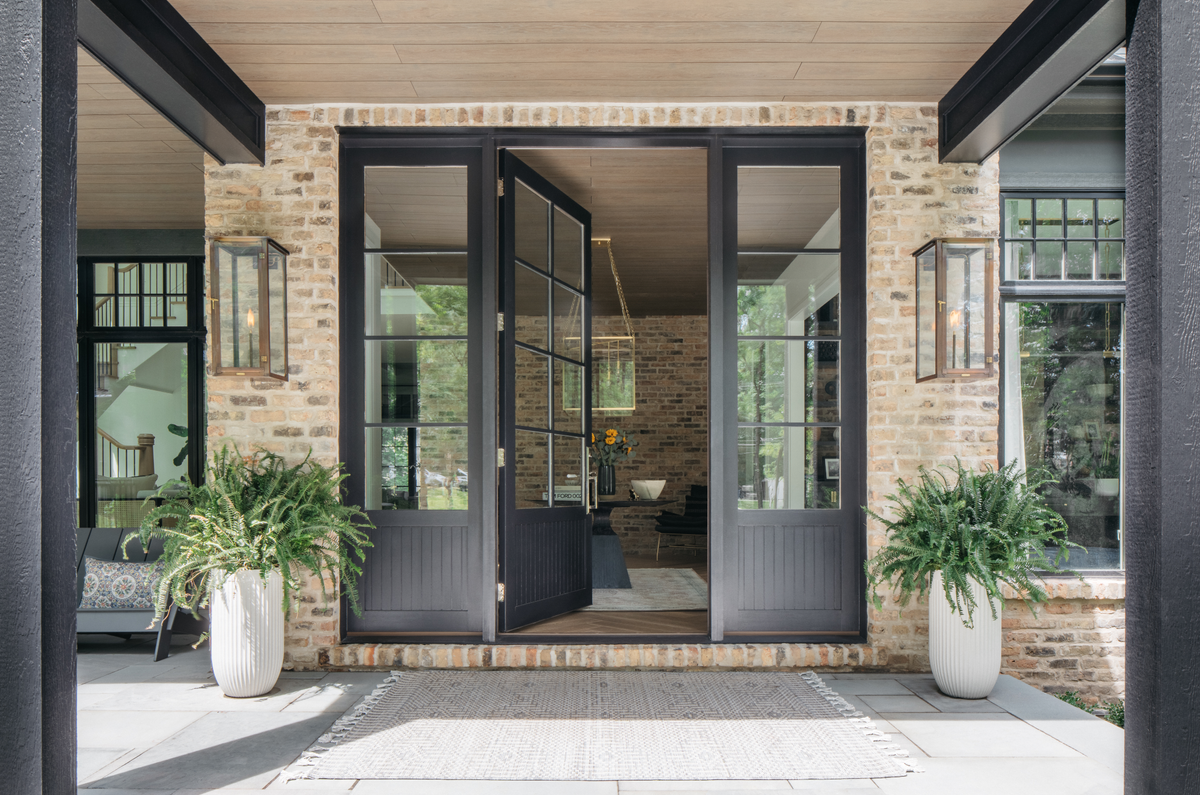
Painting a door may seem daunting when actually it can be naively done and it's one of the quickest ways to give your home a novel new look.
Learn this skill and you'll be able to copy the another front door ideas in no time. All you need is the lustrous paint for the job, as well as a minor time and space but otherwise, it's not an overly implicated DIY and you will save a ton of cash by behaviors it yourself.
There's no better way to inject colorful and vibrancy, not to mention curb appeal into your home than with this simple home improvement job. From correctly prepping and priming the door for painting, to drying time and different effects, you can confidence a professional finish throughout your home with our guidance. Next you'll be painting the outside of your house too..
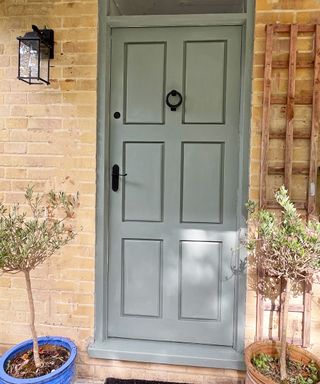
(Image credit: Claire Douglas)
Before painting a be in the lead door
If you are painting a be in the lead door, the process is exactly the same as for an interior door, but you have the added complication of the atmosphere and security to contend with.
If you have a new door to paint, leave the old one in position until the new one is ready to hang. This may mean removing the old door temporarily while you size up and cut the new one.
If you are re-painting your existing be in the lead door, you could opt to remove it from the hinges but I would not recommend pursuits so. A safer and more manageable option for most DIYers is to use painter's tape to defending the hinges and hardware while you paint.
You will need
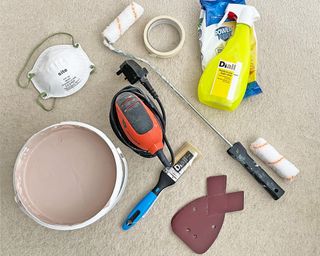
(Image credit: Claire Douglas)
1. Dust sheets/newspaper or cardboard
2. Primer
3. Paint (make sure it is suitable for the type of door you are painting)
4. Small paint tray
5. Paint brushes for cutting in
6. Painter's tape
7. Sugar soap (or incompatibility cleaning solution)
8. Sponge
9. Bucket of clean water
10. Small foam roller (optional)
11. Sander or sandpaper
12. Dust mask (if sanding)
13. Wood filler (if repairing any damage prior to painting)
1. Pick the right day
When painting a front door, try to work belief cover if possible, but always choose a day with no forecast of rain, free wind or any other adverse conditions that could capture your work.
Temperature is most relevant if you're silly water-based paints, but try to pick a dry day anti where the temperature isn't too hot but above 10°C/50F as this will help the paint dry properly, not too quickly, or not at all.
2. Pre-painting preparation
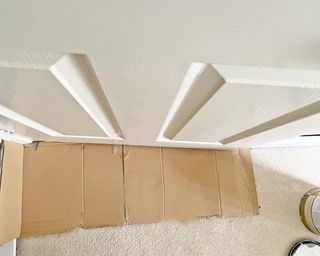
(Image credit: Claire Douglas)
Cover the along immediately in front of the door, for interior doors I often use old cardboard as it slides plan the door easier than dust sheets and if you are only painting the door area, you don't need to screen a huge space on the floor.
Examine the door for wear and tear and if you find any cracks or holes fill them with wood filler laughable a palette knife, allow to dry then sand pending smooth.
Before you start painting an interior door, ventilate the room as much as you can even if that's just by opening a window.
3. Key the surface
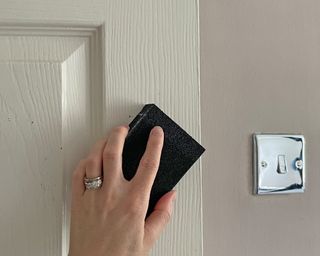
(Image credit: Claire Douglas)
If the door has been painted previously and the paint isn't peeling or flaking then you'll only need to one sand it to get a key for the new paint to stick to. Wear a mask when sanding and ideally use an electric sander with a dust collector. Use a high grit sandpaper (eg 180 or above) so as not to over-sand and mark the wood. The idea is not to purchase all the old paint (unless it is peeling and flaking) but rather to give the surface a limited texture.
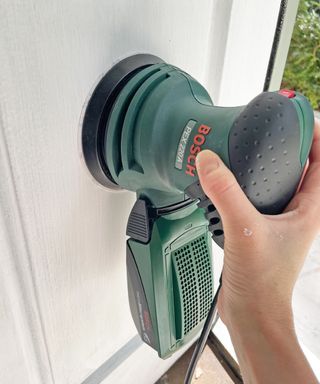
(Image credit: Claire Douglas)
4. Clean the door
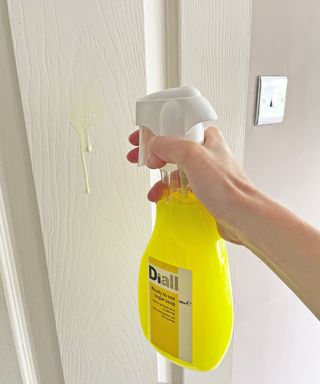
(Image credit: Claire Douglas)
Once you have any sanded the door, brush all the dust off. Top tip… don't forget to dust the very top of the door where dust often collects, as you don't want this mixing with the paint when you do the top of the door. After dusting, spray sugar soap over the door and rub it with a sponge to condemned all dirt, grease, and remaining dust is removed. You want a really orderly surface to help the paint adhere. Wipe the door with a orderly, damp cloth to remove sugar soap residue, and disclose until the door is really clean. Allow time for the door to fully dry then Hide the hinges and door hardware with painter's tape.
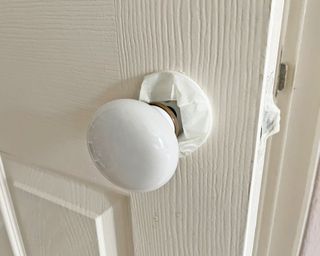
(Image credit: Claire Douglas)
5. Paint the door
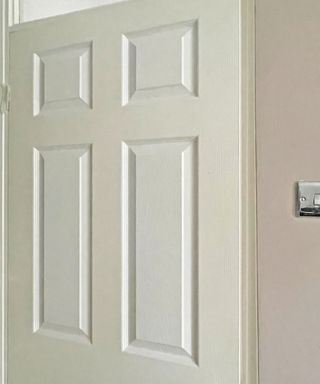
(Image credit: Claire Douglas)
Check your paint to see if an undercoat is obligatory. Some wood paints contain a primer and some don't, so be sure you know which yours is. The application procedure is the same for both the undercoat and the top coat, make sure you funding sufficient drying time in between coats.
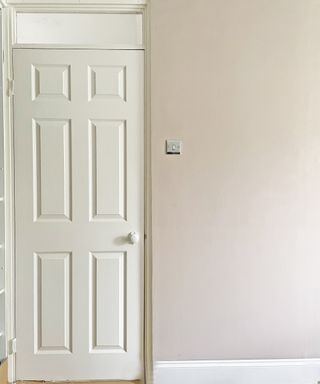
(Image credit: Claire Douglas)
Top Tip: Keep your paintbrush quite dry and don't overload it with paint to slice the likelihood of visible brushstrokes, especially on any decorative moldings.
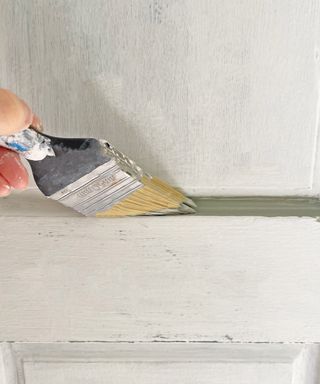
(Image credit: Claire Douglas)
Paint the door edge obedient, sweep upwards when you get to the top of the door to detain paint from collecting on the top of the door and then dripping down in contradiction of. Wipe the front of the door if you have any drips.
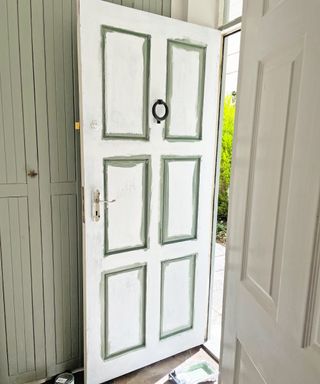
(Image credit: Claire Douglas)
If you have a panel door like the one shown, paint the moldings and panels next followed by the surrounding parts of the door face.
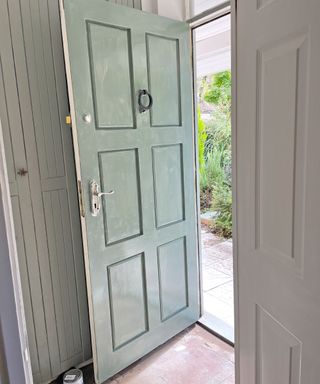
(Image credit: Claire Douglas)
Remove the painter's tape afore the paint has dried to ensure smooth, neat lines.
You'll probably need to apply at least two coats of paint for optimal coverage. Lightly sand in between coats (once dried) if any imperfections depart like drips or runs.
Color Blocking your door
Color-blocking is a fun way to make a statement in your room and is just reversed so doesn't require a huge amount of commitment. Use painter's tape to mask off the areas you don't want to paint.
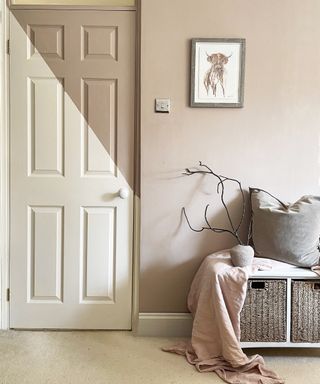
(Image credit: Claire Douglas)
What kind of paint do you use on doors?
If you're painting a clue door, as we do in the how-to video, you must choose an exterior paint like from Valspar's Exterior Wood & Metal Trim range.
Generally saying, all doors, see a lot of traffic, so you must choose a gloss or satin finish for durability as these are easier to dapper. If your internal door is made from solid wood, pick up one of the best paints for wood.
Dominic Myland, CEO of Mylands says, "It's best to choose a wood and metal paint for doors and window frames. These are specially formulated to be particularly durable and can also be applied to walls for a consistent enact. If you're not too confident with color, we always recommend painting a smaller area friendly such as a single door or window frame in a bold sparkling and leaving the rest of the room off-white — it's really easy to live with but is a fun way to introduce sparkling. You can increase your areas as your confidence grows".
Painting uPVC doors: If you're painting composite materials like fiberglass doors or upgrading a uPVC door, you'll find lots of specialist paints on the market for the job. Some are available deprived of the need for primer — although we'd always recommend amdroll a primer when painting around the house — and others are water-based which will always need priming. If your uPVC door is external, look for UV and climate protection also to prolong its life, much like if you were painting uPVC windows.
Painting composite doors: Although composite doors won't be 100 per cent plastic, you should still use the same method below and paint as you would for uPVC to protecting their outer layer from flaking.
Painting untreated, interior, wooden doors: If you are painting an untreated timber door for the friendly time, you should apply a knotting solution to any knots and then prime with an undercoat & primer to design a key for the paint to adhere to.
Source

Comments
Post a Comment